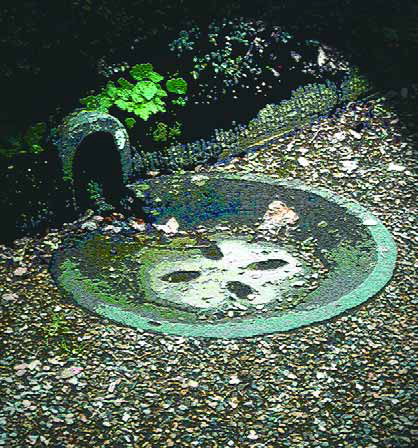installation
Serenity, comfort, repose. Delight in harmony with nature. These were the guiding principles behind The Point, one of 114 elegant homes gracing the 145-acre Hybernia development on the western boundary of Highland Park, a celebrated Chicago suburb located about 25 miles from downtown on a stretch of Lake Michigan known as the city's North Shore. We were initially called to Hybernia by a true visionary, David Hoffman, president of Red Seal Homes, the prime contractor for the development. He told us how his firm had struggled for years to acquire the parcels included in the development and wanted us to see that he was sensitive and attuned to the special nature of the setting and the history of its community. His first request: a design for a building that would house a pool and hydrotherapy spa for two of his most discriminating clients as a safe, secluded, calming harbor from their heavy international business travels. As it turned out, however, this was just the beginning of what would
There's something in human nature that loves the unexpected. From pulling open gifts wrapped in paper, ribbons and bows to the thrill of rounding a forest trail to come upon a waterfall, the sense of anticipation and discovery adds spice to life and generally keeps things interesting. As designers of watershapes and landscapes, we have a tremendous opportunityto use the excitement that comes along with the process of progressively experiencing an environment. And the nice thing about setting up spaces that unfold as you move through them is that they can be organized around simple elements, from free-standing walls, steps or hedges to trees, fences and just about anything else thatpartially blocks, disrupts or interrupts a view. This project, which was first covered in "Details" in the December 2004 issue, is a perfect example of using a sense of
Watershaping advanced by leaps and bounds from 1999 through 2004 – a journey of artistry…
So often, design comes down to an ability to see patterns. I first learned this from my mother, a dressmaker who had an uncanny ability to look at garments for which there were no sewing patterns and then sit down and make them from scratch. I seem to have inherited this talent, taking in a barren landscape and quickly visualizing how it will look with plants, rocks and water. For this, I am happily in her debt. Not everyone comes across such a gift by birth, but I believe that the ability to visualize is something most any watershaper can develop through experience and by taking the time to learn the "language" of any
It only stands to reason that you can't have a watershape without the water, but I sometimes wonder just how much watershapers really know about
Maximizing the potential of landscape lighting is always about thinking ahead - a philosophy that absolutely applies when it comes to planning and designing the lighting for a watershape. The process begins with a set of questions that should be considered at the outset of any project: Is the watershape to be the focal point of the composition, or is it to be one among equally important features such as plantings, sculptures or hardscape details? Is the feature to be visually prominent at night, or is it to blend in with the darkness? Will the water you are lighting be in motion, or are you working with a still surface? Observers and chief vantage points also come into play. If the feature will mostly be viewed from passing automobiles rather than by pedestrians, for example, the issue of glare must be directly considered for safety reasons. If the watershape is to be seen from a lit interior space, then we know that its lighting level must be equal to or greater than that of the interior lighting. Likewise, relative brightness is an issue in making the illuminated watershape work with the rest of an illuminated landscape. The most important need in all of this is for
I'm steadily reminded of one key point: No matter how talented any one of us might be, the work ultimately is not about us. For intensely creative people equipped with the necessary measures of self-confidence and ego, that point can be tough to accept and absorb, but it's true: For all our skills, we nonetheless work with our clients' visions, and the reality is that creating sympathetic designs for them takes time, patience and lots of effort. As a result, I'm passionate about uncovering what my clients are truly after in their garden and watershape designs. It's an investment of time and energy at the onset of the relationship that always
In preparation for creating plant palettes for my projects, I typically spend hours poring over my Sunset Western Garden book. I thrive on finding plants I haven't tried before, and I look especially for those I haven't seen in anyone's garden. Before I'll try any of these discoveries out on someone else, however, I'll pick up a sample plant and bring it home to my own garden - part science project, part proving ground to see how the plants perform away from the nursery. I've had many successes through the years and probably as many failures, but I learn something from every attempt. What I sometimes find are plants that are
When I first walked the four acres of wooded ravines of what would later be christened "The Garden of Wind and Pine" at the heart of the Garvan Woodland Gardens in Hot Springs, Ark., I was both delighted and daunted by the experience. The delight came in the site's sublime natural beauty, which reminded me of tromping through the woods as a child - an activity I enjoy to this day. As for my sense of unease, I don't know which was more significant: the expansiveness of the dry drainage ravines that were to be converted to ever-varying cascades and streams, or the omnipresence of ticks and poison ivy. When I made my first visit in the fall of 1999, the site was part of an undeveloped 210-acre woodland parcel on the shore of Lake Hamilton given to the Department of Landscape Architecture at the University of Arkansas in Fayetteville by Verna Garvan. She had long seen the peninsula as the ideal setting for a botanical garden and had spent two decades developing her vision, planting camellias and azaleas and a rose garden and commissioning a pavilion by the architect Fay Jones and his partner, Maurice Jennings. I had worked in Fayetteville before, crafting a
Some people seem to believe that designing is all about reinventing the wheel every time they go to work on a new project or need to create a new detail of some kind. Truth is, however, that most great design ideas and details are derivative of things that have been done before. This is why I'm such a strong advocate for education - especially the sort that involves venturing out into the world and seeing things with your own eyes. You can see pictures of things in books and watch slide shows in classrooms, and that's extremely valuable for the way it opens your eyes to






















